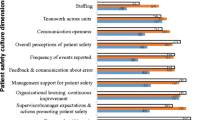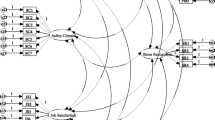Abstract
Background
The measurement of safety culture, the way in which members of an organisation think about and prioritise safety, in a hospital can provide valuable insight and inform quality improvement strategies.
Aims
The aim of this study is to describe the safety culture of a university teaching hospital in the Republic of Ireland.
Methods
This is a mixed methods survey study using the Safety Attitudes Questionnaire (SAQ). The SAQ was distributed to all staff in the study hospital. Staff attitudes towards six domains of patient safety culture were assessed over 32 Likert-scaled items. Thematic analysis was performed on qualitative data.
Results
A total of 768 staff members completed and returned a copy of the SAQ. The hospital scored above the international benchmark in five out of six domains, indicating a positive safety culture, but scored below the international benchmark in the domain ‘Working Conditions’. This positive safety culture was not mirrored in the qualitative data, from which five themes emerged; three major—Staffing Issues, Patient-Focused Care and Hospital Environment—and two minor—Safe Reporting Culture and Training and Education.
Conclusions
In this study, a mixed methods approach was successfully used to investigate the safety culture in a large Irish hospital. Although the SAQ results indicated a positive safety culture, the qualitative data revealed a number of issues that the hospital staff felt impacted negatively on patient safety. The results of this study will inform future work on the design of an intervention to improve patient safety in the hospital.
Similar content being viewed by others
References
World Health Organization. WHO Global Patient Safety Challenge: Medication Without Harm.; 2017. http://apps.who.int/iris/bitstream/handle/10665/255263/WHO-HIS-SDS-2017.6-eng.pdf;jsessionid=3E1008872FACBAF6C1DA69CEEE3A753F?sequence=1
National Coordinating Council for Medication Error Reporting and Prevention. What Is a Medication Error?; 2015. http://www.nccmerp.org/%0Aabout-medication-errors, accessed 19 September 2016
Groves PS (2014) The relationship between safety culture and patient outcomes: results from pilot meta-analyses. West J Nurs Res. https://doi.org/10.1177/0193945913490080
Sorra J, Gray L, Streagle S, et al. Hospital survey on patient safety culture: user’s guide.; 2016
Kaya S, Barsbay S, Karabulut E (2010) The Turkish version of the safety attitudes questionnaire: psychometric properties and baseline data. Qual Saf Heal Care. https://doi.org/10.1136/qshc.2008.032003
Nguyen G, Gambashidze N, Ilyas SA, Pascu D (2015) Validation of the safety attitudes questionnaire (short form 2006) in Italian in hospitals in the northeast of Italy. BMC Health Serv Res 15:1–8. https://doi.org/10.1186/s12913-015-0951-8
Boussat B, Kamalanavin K, François P (2018) The contribution of open comments to understanding the results from the hospital survey on patient safety culture (HSOPS): a qualitative study. PLoS One. https://doi.org/10.1371/journal.pone.0196089
Sexton JB, Helmreich RL, Neilands TB et al (2006) The safety attitudes questionnaire: psychometric properties, benchmarking data, and emerging research. BMC Health Serv Res. https://doi.org/10.1186/1472-6963-6-44
Relihan E, Glynn S, Daly D, Silke B, Ryder S (2009) Measuring and benchmarking safety culture: application of the safety attitudes questionnaire to an acute medical admissions unit. Ir J Med Sci 178(4):433–439. https://doi.org/10.1007/s11845-009-0352-2
Centre for Healthcare Quality and Safety, University of Texas. https://med.uth.edu/chqs/survey/
IBM Corp (2016) Released 2016. IBM SPSS statistics for windows, version 24.0. Armonk, NY, IBM Corp
Braun V, Clarke V (2006) Using thematic analysis in psychology. Qual Res Psychol. https://doi.org/10.1191/1478088706qp063oa
QSR International Pty Ltd. NVivo Qualitative Data Analysis Software
Wall M. HSE warns of potential €881m funding crisis in 2018. The Irish Times. January 22, 2018
Wall M. Billions required to repair healthcare system, consultants say. The Irish Times September 18, 2017
Humphries N, Crowe S, McDermott C, McAleese S, Brugha R (2017) The consequences of Ireland’s culture of medical migration. Hum Resour Health 15:1–9. https://doi.org/10.1186/s12960-017-0263-7
Clarke N, Crowe S, Humphries N, Conroy R, O’Hare S, Kavanagh P, Brugha R (2017) Factors influencing trainee doctor emigration in a high income country: a mixed methods study. Hum Resour Health 15:1–12. https://doi.org/10.1186/s12960-017-0239-7
Donegan L, O’Donnell J. Influenza season influenza and other seasonal respiratory viruses in Ireland, 2017/2018. HSE Health Protection Surveillance Centre Annual Epidemiological Report.; 2018
McMullan C, Brown GD, O’Sullivan D (2016) Preparing to respond: Irish nurses’ perceptions of preparedness for an influenza pandemic. Int Emerg Nurs. https://doi.org/10.1016/j.ienj.2015.10.004
Kristensen S, Badsberg JH, Rischel V, Anhøj J, Mainz J, Bartels P (2015) The patient safety climate in Danish hospital units. Dan Med J
Acknowledgements
The authors would like to acknowledge the staff of the study hospital who gave their time to complete the survey.
Author information
Authors and Affiliations
Corresponding author
Ethics declarations
Competing interests
The authors A Delaney and D O’Mahony are employed by the study hospital; however, they were not involved in data analysis or writing the manuscript.
Ethical approval
Ethical approval for this study was granted by the Clinical Research Ethics Committee of the Cork Teaching Hospitals.
Additional information
Publisher’s note
Springer Nature remains neutral with regard to jurisdictional claims in published maps and institutional affiliations.
Rights and permissions
About this article
Cite this article
Gleeson, L.L., Tobin, L., O’Brien, G.L. et al. Safety culture in a major accredited Irish university teaching hospital: a mixed methods study using the safety attitudes questionnaire. Ir J Med Sci 189, 1171–1178 (2020). https://doi.org/10.1007/s11845-020-02228-0
Received:
Accepted:
Published:
Issue Date:
DOI: https://doi.org/10.1007/s11845-020-02228-0




